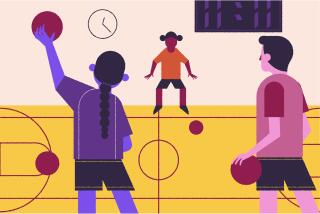Pickleball is a smash hit in SoCal. Now younger players are picking up the paddle
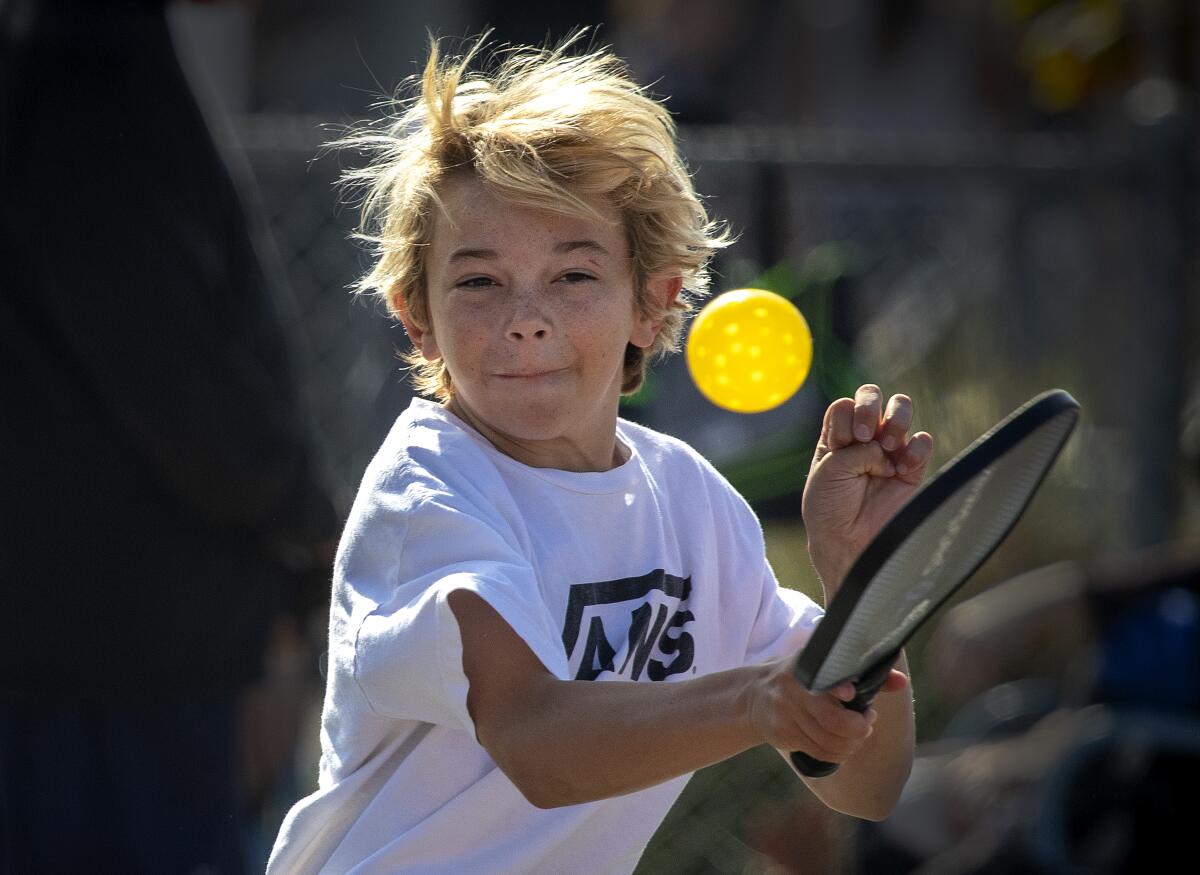
- Share via
But for a broken leg from a surfing mishap, Diana Abruscato of Huntington Beach might never have picked up a pickleball paddle. “I found I couldn’t cover the tennis court like I used to after my accident,” said Abruscato, 54, who is an “ambassador” for the USA Pickleball Assn., teaches classes and runs the annual Surf City Pickleball Tournament that’s held each July in Huntington Beach.
“Now I’m out spreading the gospel,” said Abruscato, who described the game as a combination of tennis, pingpong and badminton that’s played in a space about a third the size of a tennis court. The plastic ball is something akin to a Wiffle ball. A starter set of four paddles and balls can start at $25, while a more expensive composite or graphite paddle could set you back $150.
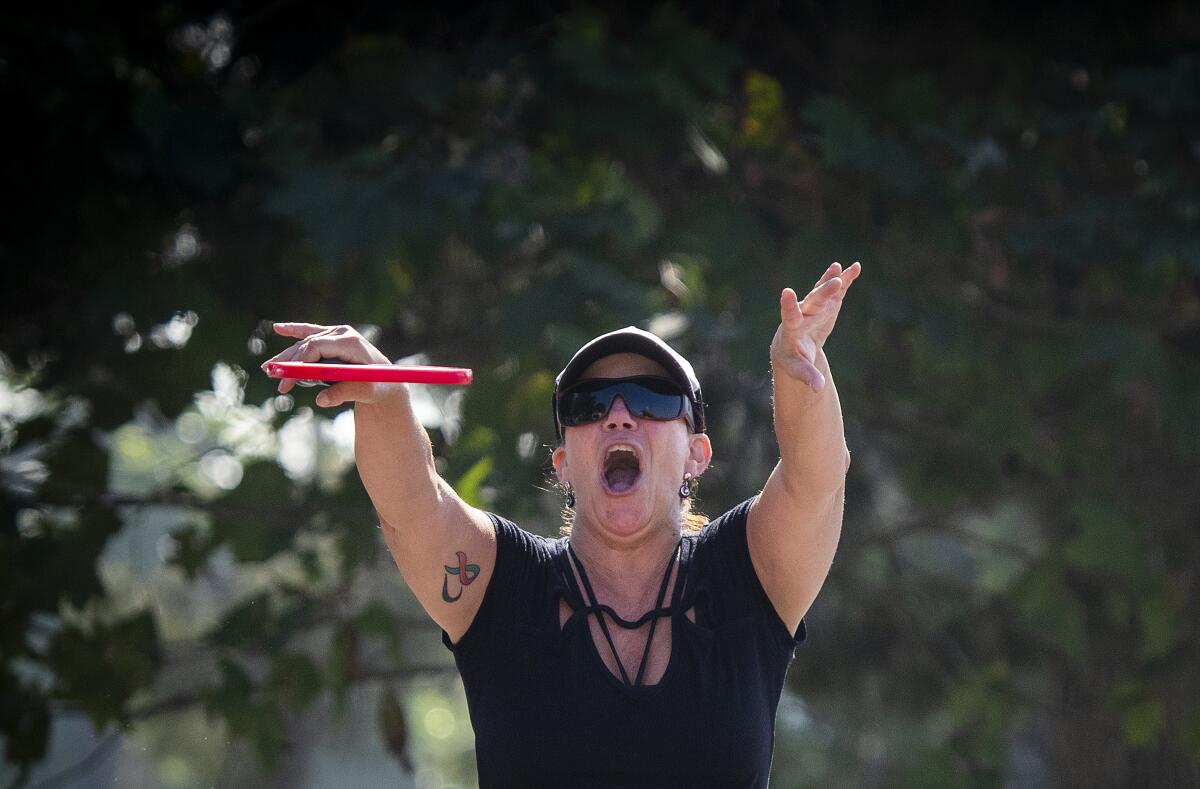
The rapidly growing sport had more than 3.1 million players in 2018, up 12% from 2017, according to USA Pickleball Assn. spokesman Drew Wathey. Scores of new courts are being added around the country each month. No specific figures are available for California, but it is one of the top five states in the nation for pickleball, along with Texas, Arizona, Nevada and Florida.
But it’s not just the older set playing pickleball.
Mark Florian, 14, of Simi Valley plays tennis and pickleball, and prefers the latter sport because it’s easier and more social. “It seems like you get to hit the ball more during a point in pickleball compared to tennis, because the pickleball court is smaller,” he said. “And it’s more fun because it helps me meet more people. You rotate positions more and get to play with other partners.” Florian can almost always find players in Simi Valley parks on any given morning. “And they usually applaud my hustle on the courts,” he said modestly.
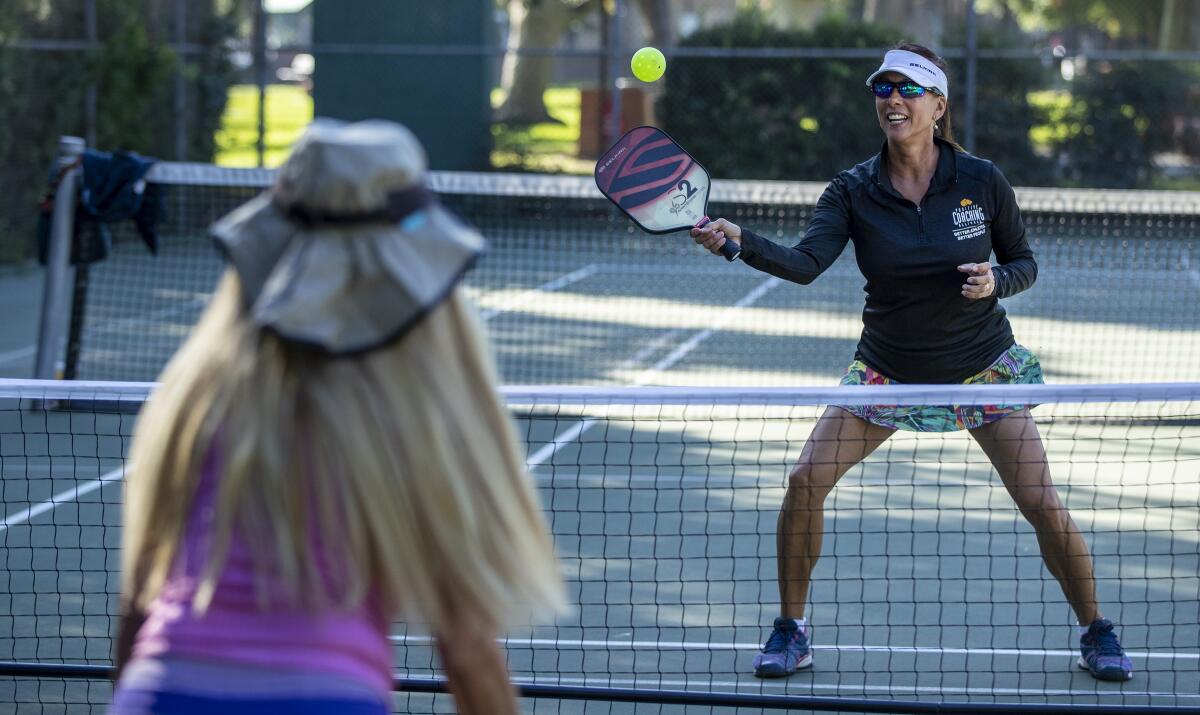
Pickleball’s roots go back to 1965, when three dads on Bainbridge Island in Washington state invented the sport for their bored kids. Paddles were improvised and rules were kept simple. As the story goes, one of the families had a dog named Pickles, hence the name. Fast-forward half a century and middle schools in places such as Simi Valley are bringing the sport to a younger and more diverse audience.
Meanwhile, ambassadors like Abruscato keep recruiting newcomers. “It’s reached a critical mass now, and I think it’s here to stay because it’s not hard to learn, is easy on the joints, is relatively inexpensive and is very social,” she said.
Paddle tennis, which uses a solid racket and a depressurized tennis ball, is competing for court space. But pickleball is more popular because, in part, the racket is lighter, smaller and easier to wield, making the game open to a wider range of participants, Abruscato said.
Eighty miles north in Simi Valley, Ed “Fast Eddie” Florian, an assistant tennis coach at Royal High School, said he and his kids, ages 14 and 16, picked up the sport about four years ago after his son lost interest in running. “We’re lucky because the Simi Valley parks and recreation department has lots of dedicated courts for pickleball,” said Florian, 47.
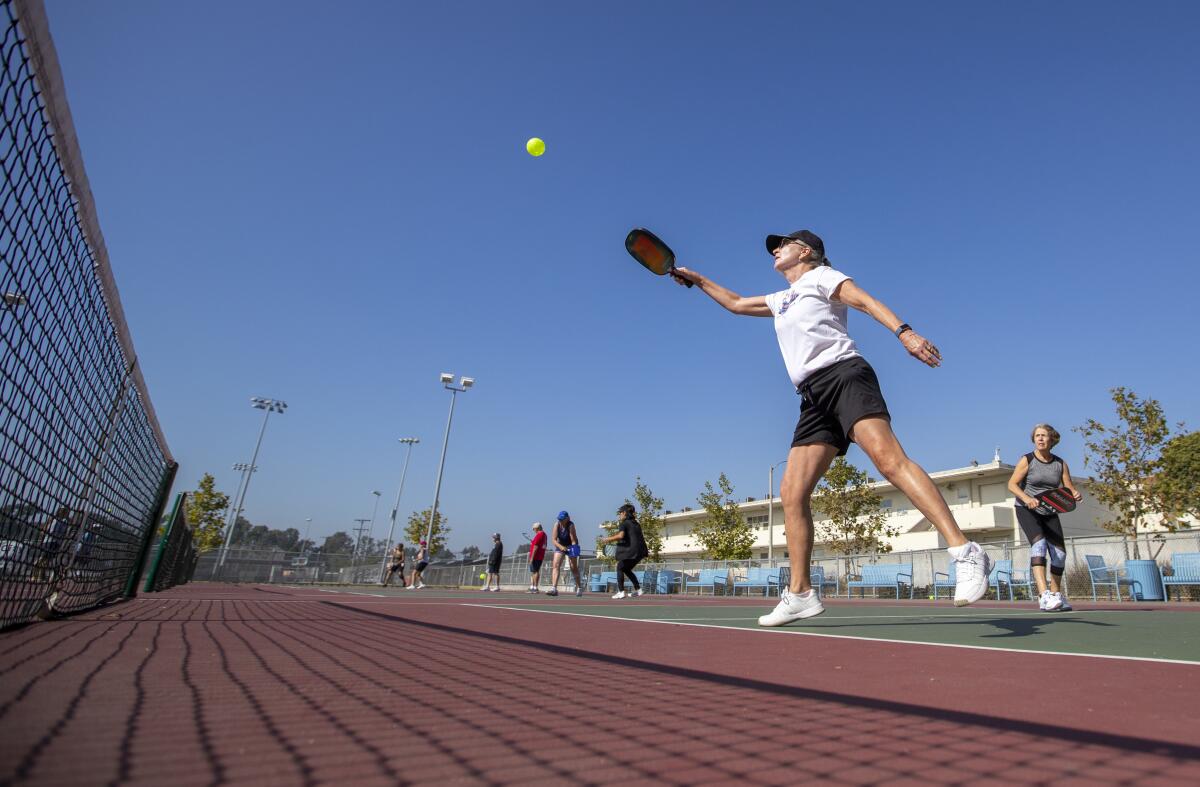
“We don’t just play here in Simi Valley either,” he added. “Since we’ve picked it up, we take our tennis rackets and pickleball paddles and balls and play both sports on every vacation that we’ve gone on.”
Florian praised the city and its school district for promoting the sport. “All three of the middle schools converted their tennis courts, which were cracked, in disrepair and without nets, into pickleball courts. And now they have a tournament between the three schools, which is a nice way to bridge the gap.”
Florian says he believes pickleball is easier to learn and play than tennis. “If you have some basic hand-eye coordination, you can do it,” said Florian, who noted that Simi Valley had pickleball leagues that players can join. “You might be walking by a court and someone will lend you a paddle and ask you to play; it’s that easy.”
While the sport is growing among kids, Rand Corp. physician and researcher Deborah Cohen said it was popular with seniors and helped get them outdoors. She said Rand recently did a national study on the use of neighborhood parks, which found that seniors were under-represented. “Park use is very disproportionate, with teens and kids over-represented,” she said. “Only 4% of the users were seniors. Even though they are 18% of the population, we hardly saw them in parks.”
One of the exceptions, she noted, was a park in the Midwest with a pickleball court.
“It’s not as taxing as tennis, so it would be great to promote it more for older adults,” Cohen said. “It takes some investment, but not a lot because you can convert existing tennis courts.”
She said pickleball also could be a good fit for low-income communities because equipment was not expensive. “Parks-and-rec departments could just loan out the paddles and balls, like they do now with basketballs,” Cohen said. “It would take some investment for nets and equipment, but not that much.”
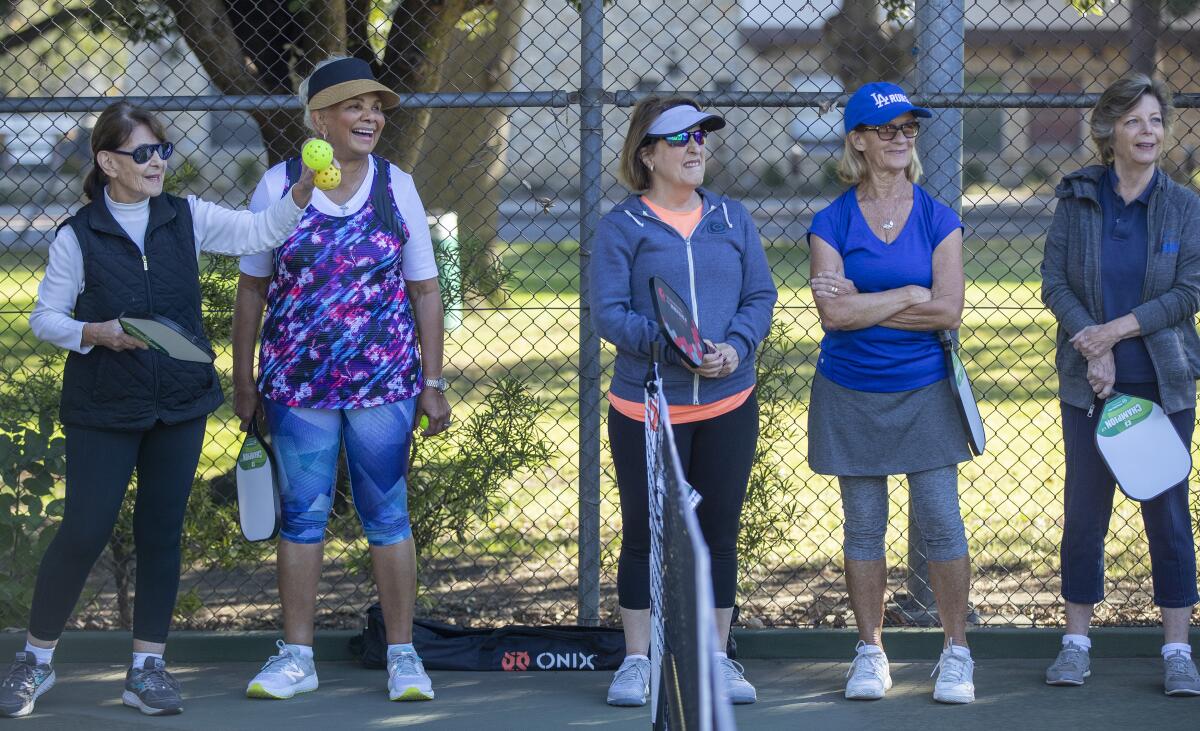
Abruscato, who at one time was a top singles tennis player, said the popularity of pickleball was growing among younger players. “It’s kind of been stereotyped as being mostly for older folks, and it’s true that the largest percentage of players is among the 50-plus set,” she said.
“But all age levels play, and there are youth programs that are growing. In fact, I teach kids and it’s part of after-school programs. It’s in three of our middle schools and three of our four high schools. So the sport is trending younger. And we’re trying to build up league play for kids.”
Abruscato said pickleball courts were popping up all over Orange County, with five dedicated facilities built in the last 18 months.
And if there aren’t any dedicated courts with posts and nets?
“You can simply tape the lines on tennis courts and use mobile nets,” she said. “Because the game is growing faster than our cities, schools, parks and country clubs can keep up, that’s what we are doing. We make do with the surfaces available, including basketball courts.
“Dedicated courts are costly to build, at around $65,000 to $75,000 per court,” Abruscato said. “Many cities are afraid to make this investment because they aren’t sure if this is a fad. But I’m sure we’ll be seeing more in the months to come. It’s a game that’s going to stick around.”
Although the sport is most popular as a game with friends, she said it could be played all the way up to the professional level. “You can make it as easy and social as you want it to be — or as competitive,” said Abruscato.
“For most folks, it’s a fun recreational activity,” she said. “I like to play at a more intense level and compete in tournaments.
“After my surfing injury, I tried golf and even soccer. But I couldn’t find anything that replaced tennis for me,” Abruscato said. “It was a gap of about a decade, and that was tough. Pickleball was a godsend for me when I was introduced to it six years ago. I’d say it was absolutely life-changing.”
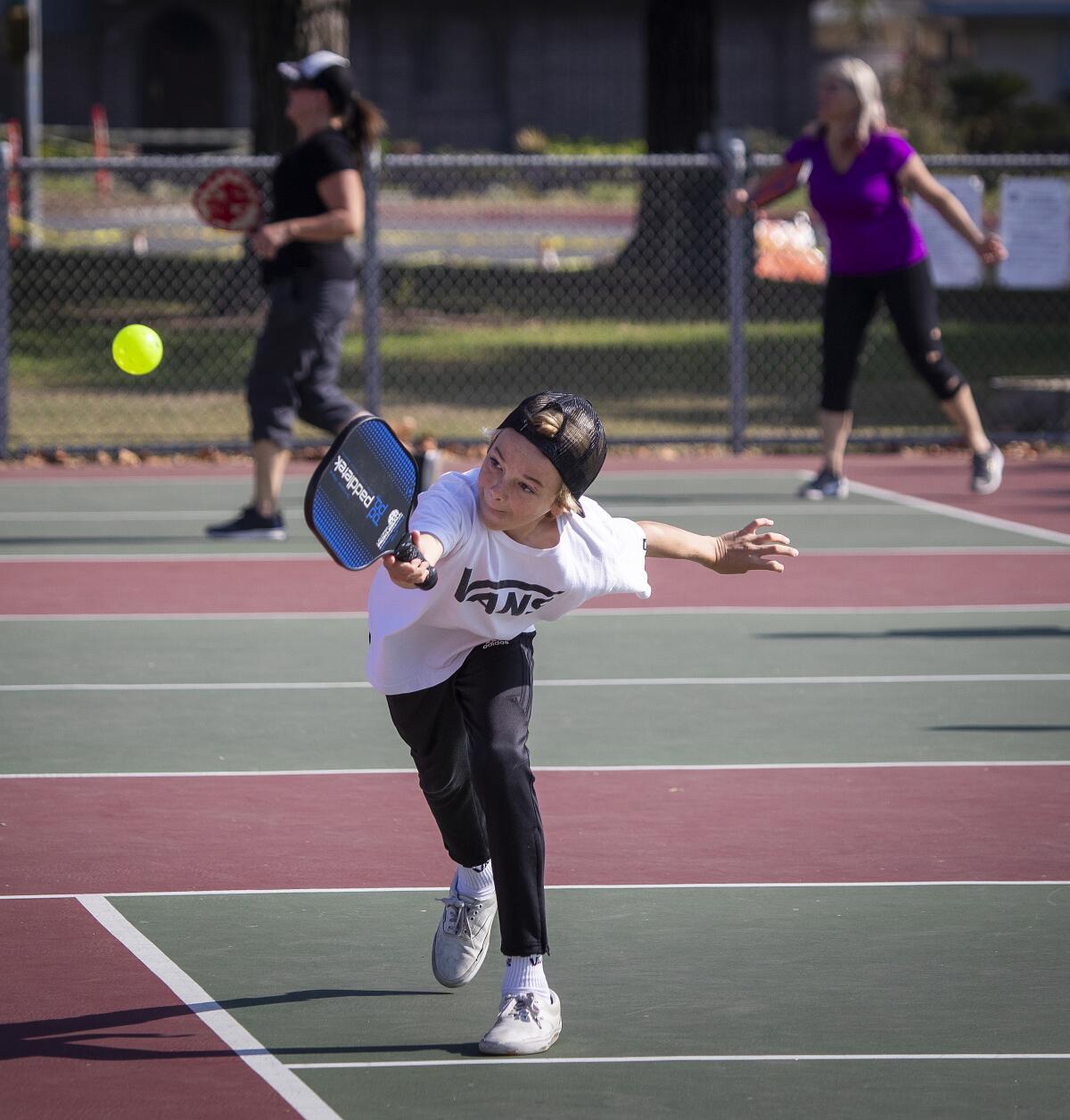
Jeaney Garcia, 57, another USA Pickleball Assn. ambassador, was a collegiate basketball player at Kansas State. She now teaches the sport as the lead instructor for the Los Angeles Recreation and Parks Department. She also teaches in El Segundo, where courts are being built, and in other cities in Southern California. Before moving to Los Angeles, she was a pickleball ambassador in Honolulu, where she continues to lead clinics at the Pacific Club.
“Friends asked me to play four years ago, and I’ve been addicted from the start,” said Garcia, a champion at the international level. “It’s now grown into a full-time gig, though a lot of what I do is as a volunteer. Really, it’s a labor of love.
“It was transformative for me to become a competitive athlete again with pickleball,” added Garcia, who took part in the recent Margaritaville USA Pickleball National Championships, held Nov. 2-10 in Indian Wells, Calif.
“People with a background in racket sports probably pick up the game the quickest,” she said. “But it’s a great activity because it’s a fit for people who aren’t as mobile as they used to be. Someone who is 80 can show up because an acquaintance recommended it as a way to have fun, get a workout and make new friends.
“Anyone who’s over 50 is considered a senior, and over 60 is a super senior,” Garcia said.
Garcia wishes every public tennis court in Los Angeles could be striped for pickleball.
Los Angeles now has 16 dedicated pickleball courts. Recreation centers in Woodland Hills and Tarzana have courts striped as part of a refurbishment program of gyms funded by the Los Angeles Clippers.
She said she’s also talking with Leslie Richter, who is in charge of Los Angeles’ 29 senior centers, about striping lines on center tennis courts to make them dual-purpose.
“Pickleball is a happening thing,” agreed Richter, 56, a former tennis player who has taken a lesson from Garcia. Richter describes herself as a beginner but has competed in two tournaments.
“It’s a great sport for all ages but is especially good for older adults who want to stay active,” Richter added.
Garcia said she looked north to Simi Valley as the “gold standard” for pickleball because of its numerous dedicated courts around the city of 130,000.
“That city got on the pickleball bandwagon a while back and has made a major commitment to the sport,” she said. “People from around the country go there to take part in their tournaments. I’d say we’re taking baby steps now in Los Angeles and I’d love to replicate what Simi Valley has done.”
Places to learn and play for free
Encino Community Center, 4935 Balboa Blvd.; four pickleball courts behind the community center, across the street from the elementary school
Granada Hills Park, 16730 Chatsworth St.; four courts south of the community center
Tarzana Recreation Center, 5655 VanAlden Ave.; two courts
Woodland Hills Rec Center, 5858 Shoup Ave.; four outdoor courts on Farralone Avenue
El Segundo Park, 401 Sheldon St.; four courts next to the volleyball area
Sinaloa Middle School, 301 Royal Ave in Simi Valley; 12 courts open to the public on Saturdays and Sundays
Worthy Community Park, 1801 Main St. in Huntington Beach; four lighted courts
More to Read
Sign up for The Wild
We’ll help you find the best places to hike, bike and run, as well as the perfect silent spots for meditation and yoga.
You may occasionally receive promotional content from the Los Angeles Times.


